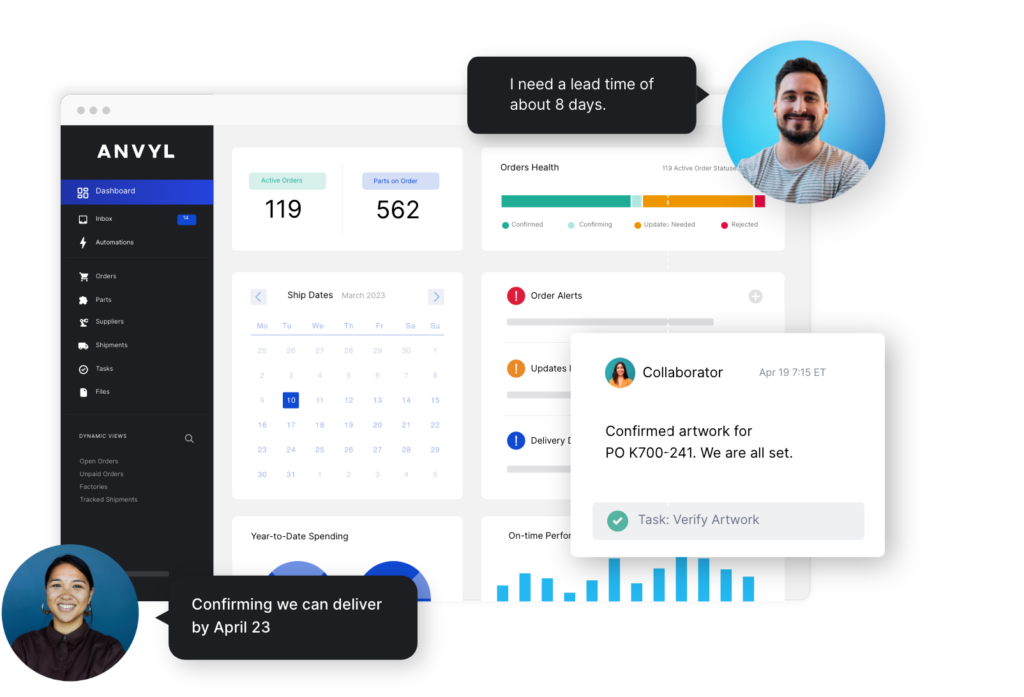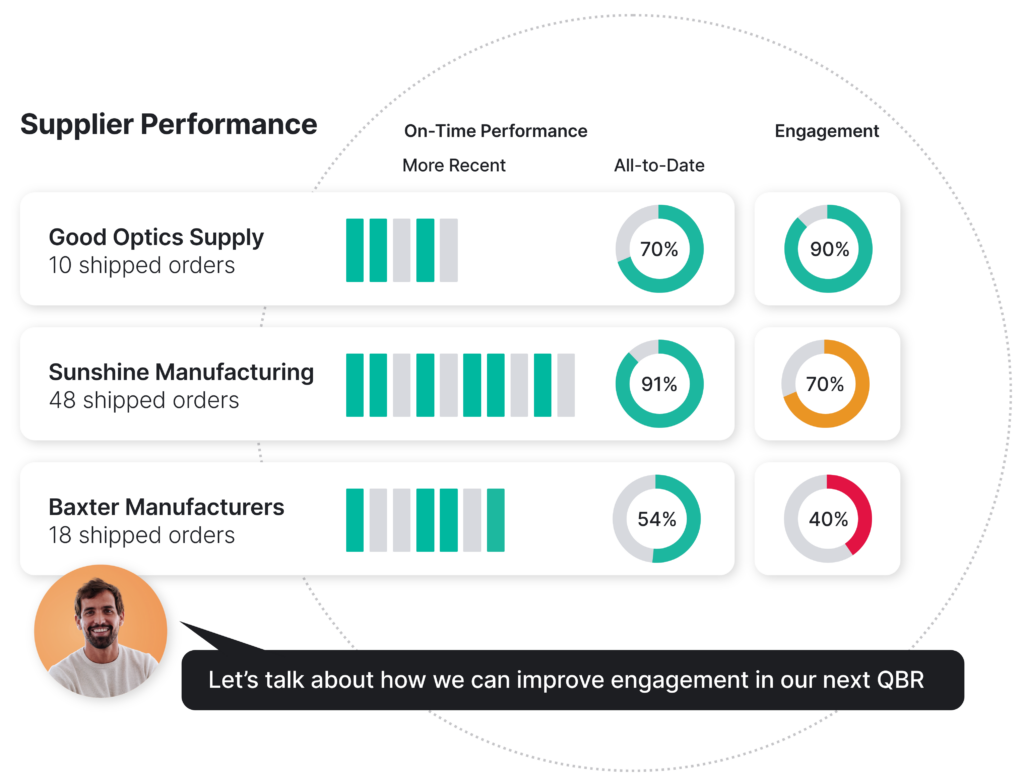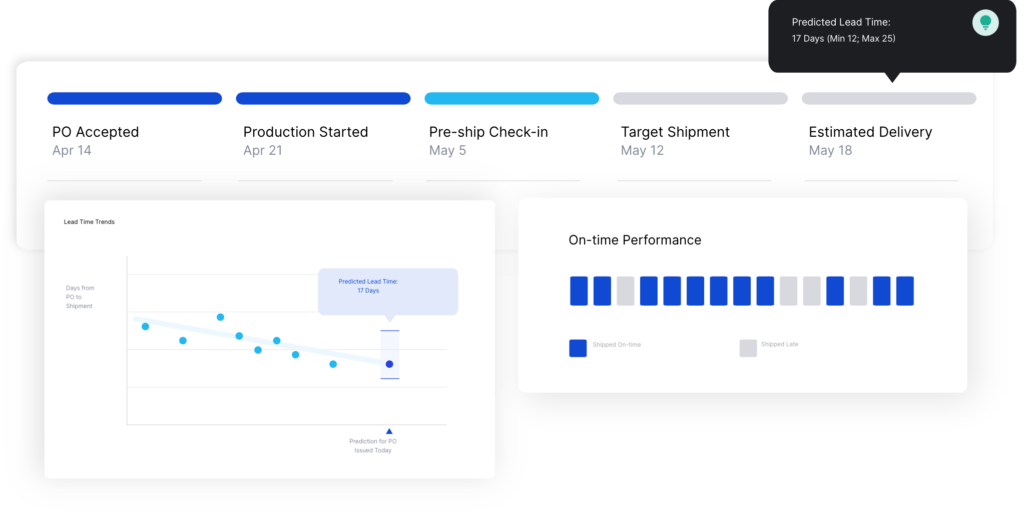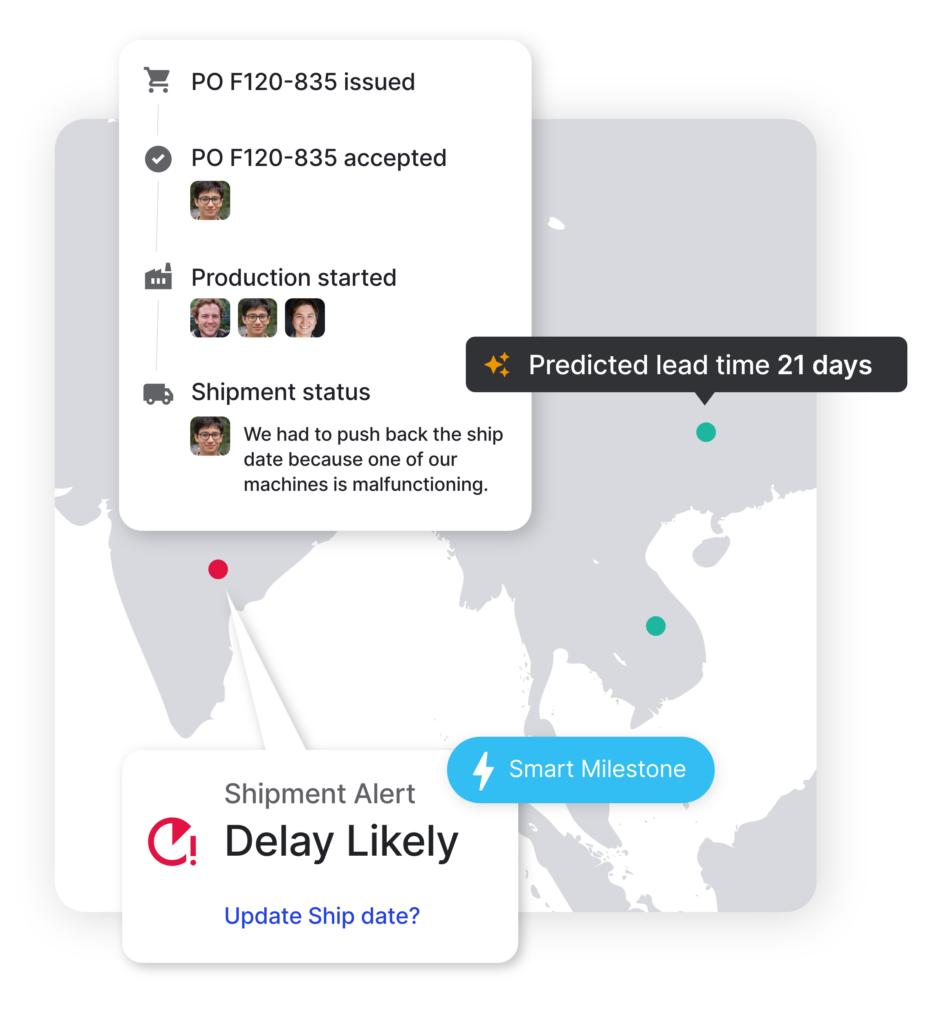The Ultimate Guide to Supply Chain IntelligenceUncovering Key Insights Through Data
Today, brands have access to new technology to manage their supply chains more efficiently and effectively.
Where brands once had to rely solely on manual tracking methods like spreadsheets and emails to manage workflows in their supply chain, they can now use new supply chain technology to automate critical tasks and transition through purchase order milestones more efficiently.
This also provides new opportunities for brands to leverage data throughout their supply chain to uncover valuable insights that would otherwise remain buried in disorganized, outdated processes.
However, the sheer amount of data from across the supply chain can be overwhelming for brands to unravel—especially if that data is scattered across disparate systems.
Disconnected data is just one of the many challenges brands face when it comes to managing their data analytics in supply chain.
Our recent State of Supply Chain survey found that consumer brands cite poor data quality (35%), data inaccuracy and inconsistencies (34%), and delays in data processing and analysis (30%) as just some of the data problems within their supply chain.
The good news is that brands can overcome these challenges with the right supply chain reporting tools and technology.
When brands learn to leverage the power of their own supply chain data through better supply chain tracking, reporting, and intelligent decision-making, they can better react to change, mitigate risks, control costs, and more.
But where to begin?
In this guide, we’ll explore how brands can centralize data from across their business into one system, leverage dynamic reporting that updates in real-time, and use dashboards to understand what’s happening in their supply chain to take action that drives better outcomes for their business.
We’ll cover:
- The traditional supply chain compared to an intelligent supply chain and why it is crucial for modern consumer brands
- The most common challenges of supply chain management (SCM) analytics and how supply chain data and reporting can help
- Key metrics every brand should measure as part of their supply chain tracking and reporting.
But before we dive in, it’s important to understand the difference between a traditional supply chain and an intelligent supply chain and the role data and reporting play in both.
What is a traditional supply chain vs. an intelligent supply chain?
Traditional supply chains rely heavily on manual tracking and reporting, such as spreadsheets, emails, or even back-and-forth phone calls, to track things like order quantities, shipments, supplier communications, etc.
These tracking and reporting methods are the norm for many brands, especially when they are new to launch or just starting production. However, relying on manual tracking methods ultimately impedes growth, increases the risk of errors, and makes it challenging to manage increasing demand when it’s time to scale.
More importantly, traditional reporting prevents supply chain teams from having complete visibility into their supply chain.
Reacting to low probability high-impact events such as geopolitical tensions, war, increasingly severe weather, and even a global pandemic becomes even more challenging without complete visibility into the supply chain.
To face this challenge, brands need to reconsider how they use data, reporting, and technology to get better visibility across their supply chain.
In contrast to the traditional supply chain, an intelligent supply chain centralizes supply chain data and provides real-time access to the most important information and KPIs from across your supply chain.

Gathering, tracking, and analyzing important KPIs in one central platform reduces errors and gives you more time to focus on the most important aspects of running your supply chain.
We’ll explore the most important supply chain KPIs to track later on. But let’s move on to some of the top supply chain data challenges brands face and how supply chain intelligence can solve them.
Top Supply Chain Data Challenges
Supply chains are dynamic, with inventory levels, supplier performance, and demand patterns constantly changing. Ensuring that data is accurate and up to date is critical for making informed decisions. But this isn’t always easy, especially if you’re still using disconnected systems.
Our State of Supply Chain Survey found that disconnected data is just one of the top challenges consumer brands face when it comes to managing data analytics in supply chain.

Overcoming these top supply chain data management challenges requires a systematic approach—and the most important place to start is by ensuring more accurate data across your entire supply chain.
Challenge #1: Data Accuracy
Inaccurate supply chain data leads to inefficiencies, increased costs, and even compromised customer satisfaction—especially when inaccurate data disrupts workflows and results in delayed shipments and stockouts.
Supply chain operators on your team likely feel the pain of inaccurate data the most.
Why?
They face the daunting (and tedious) task of regularly sifting through fragmented data sources to determine urgent priorities.
They also need a clearer, straightforward way of knowing what requires their immediate attention and what can wait to be addressed after the big fires have been put out.
Inaccurate data means it’s also easier to make additional mistakes that can slow down the movement of goods throughout the rest of the supply chain and prevent your operators from knowing if things like order statuses are truly up to date.

Maintaining accurate data throughout your supply chain ensures that your team makes decisions based on the most up-to-date information available at any given point in your process.
This drives more informed decision-making and minimizes errors that can add up to higher costs and wasted time spent correcting miscalculations.
Implementing an integrated data management system, such as supply chain management software, is one of the best ways to ensure that your data is accurate and updated in real-time.
SCM software consolidates information from disparate sources into a single system and, more importantly, removes silos that prevent you from having complete visibility into your supply chain.
Challenge #2: Siloed Data and Low Visibility
Siloed data and low visibility are incredibly challenging for supply chain managers, who need a holistic view of the status and risks across their supply chain at any given moment.
If your supply chain managers rely on cumbersome processes to cobble together data from multiple sources—whether that data lives in various spreadsheets or multiple software systems—they not only lose the ability to assess the big-picture status and identify potential risks but also waste precious time that could be better spent optimizing their supply chain for overall efficiency.
The solve?
Implementing technology that includes comprehensive data integration and visualization, like dashboards is the best way for supply chain managers to access all of the most critical information from across their supply chain in a single view.
Supply chain dashboards should also allow managers to tailor data views according to their specific needs and preferences. This flexibility allows them to extract the most actionable insights from their supply chain data.
With dynamic data views, supply chain professionals can easily adjust the layout, filters, and data visualization options to focus on the most relevant information for their current tasks or objectives.
Access to all of the most important data within one dashboard increases overall visibility into the supply chain, making it easier to react to sudden changes and mitigate risk.
Challenge #3: Actionable Insights
Gathering and reporting on data from across your supply chain is crucial, but it’s even more important to analyze data and make decisions based on it.
This is especially important for supply chain executives or senior leadership tasked with distilling all of the data to make overall business decisions.
Relying on outdated reporting systems or fragmented analytics tools that provide limited visibility into supply chain performance also hinders your executive team from capitalizing on emerging opportunities, which can ultimately impede growth.

By contrast, timely access to relevant performance data enables executives to identify trends, anticipate market shifts, and capitalize on new growth opportunities.
Implementing intelligent supply chain management tools that include automation, machine learning algorithms, and real-time reporting capabilities is the best way to give executives timely access to relevant performance data.
As a result, they can identify trends, anticipate market shifts, and capitalize on new growth opportunities.
No matter how you address data challenges in your supply chain, your overall supply chain tracking should continue to evolve as your business grows.
Processes or platforms that once worked best for you at one stage of your business might not necessarily work well once you grow.
Evaluate your reporting and data management practices regularly to ensure that your team can continue to make the best possible decisions in your supply chain.
Key Supply Chain Metrics and Reports
The more complex your supply chain, the more challenging it can be to narrow down the most important key performance indicators to pay attention to to measure the overall efficiency of your supply chain.
The good news is that intelligent supply chain technology makes it easy to gather, track, and analyze your most important KPIs since all of this data sits in one central spot.
While there are seemingly endless possible metrics to track across your supply chain, we’ve narrowed down the most important ones across the three main areas of your supply chain: Supplier Performance, Orders, and Deliveries.
Key Supply Chain Metrics and Reports
Suppliers are not just sources of your material and products. They are key partners in your success.
Therefore, the ability to measure supplier performance is important not only to optimize costs but also to maintain better quality control with products and raw materials throughout the procurement process.
It’s also a tool to help you build and maintain strong supplier relationships.
Some metrics to measure include:
- Supplier Engagement Rate: Measure the level of collaboration and communication with your suppliers, including responsiveness, issue resolution speed, and the quality and consistency of their products.
- Supplier Scorecards: Quantify and assess your suppliers’ performance and reliability. Get a comprehensive view of a supplier’s ability to meet contractual obligations, deliver quality products or services, and identify the top areas for improvement.

- On-Time Performance: Measure the percentage of orders confirmed ready by the shipment date on the initial accepted purchase order.
Order Metrics
The most important aspect of managing the first mile of your supply chain is tracking the movement of purchase orders.
Order metrics help you measure your overall efficiency in moving purchase orders through your supply chain and serve as strong indicators of customer demand.
- Order Volume: Measure the total number of orders your business receives within a specified timeframe.
- Order Accuracy: Measure how purchase orders are created and fulfilled correctly and without errors. This KPI ensures supplier relations, operational efficiency, and overall supply chain performance.
- Order Delays: See the percentage of purchase orders that experience delays in processing, manufacturing, or shipping.
A high amount of order delays is likely the result of poor PO management internally or weak communication with suppliers at important touchpoints along the way.

Shipment Metrics
Measuring things like lead time, inventory turnover, and transportation costs per unit helps ensure that you keep costs low when shipping products to your warehouse and helps you appropriately plan capacity when products are in transit.
- Lead Time: Track the time it takes for an order to be fulfilled from the moment it’s placed.

- Inventory Turnover: Quantify the efficiency of your inventory management processes and reflect how quickly you sell the inventory you hold.

- Transportation Cost Per Unit:Evaluate the efficiency and cost-effectiveness of your transportation operations since cost can vary based on air, ocean, or land transportation. It assesses the cost incurred to transport each product unit, goods, or materials, reflecting your supply chain’s performance and financial health.
The Role of Integrations
Integrations are crucial to any intelligent supply chain. They help synchronize data across larger systems, streamline processes, and eliminate manual data entry errors.
For example, integrations with inventory management systems enhance visibility into inventory levels, demand forecasting, and order fulfillment processes.
And ERP integrations can provide further context to your supply chain effectiveness by pulling in important financial information from other business areas.
If you’re considering bringing on new supply chain technology, make sure that it will integrate with your existing tech stack to get the most out of your investment in multiple tools.
Conclusion
Traditional methods of supply chain management, such as manual tracking and reporting, are no longer sufficient to meet the demands of modern consumer brands.
The emergence of new technologies offers exciting opportunities for consumer brands to revolutionize their supply chain processes and gain a competitive edge.
By embracing intelligent supply chain solutions, brands can centralize data and tracking, providing real-time insights and visibility into every aspect of their supply chain.
This shift enables proactive decision-making and agility in response to disruptions and fosters collaboration across the entire supply chain ecosystem.
By harnessing the power of intelligent supply chain solutions, brands can unlock the full potential of their supply chain data, driving growth, efficiency, and resilience no matter how the market continues to evolve.